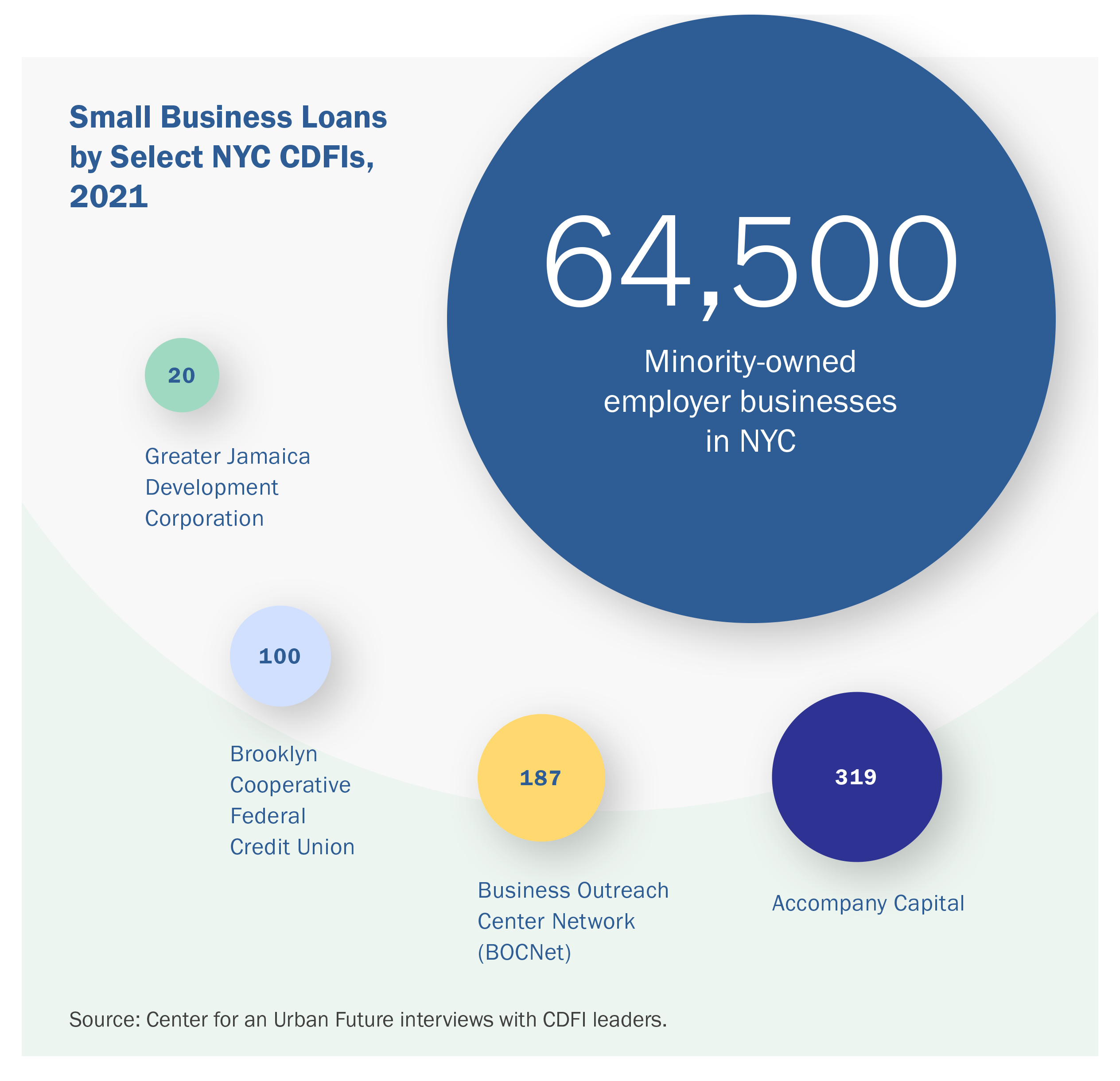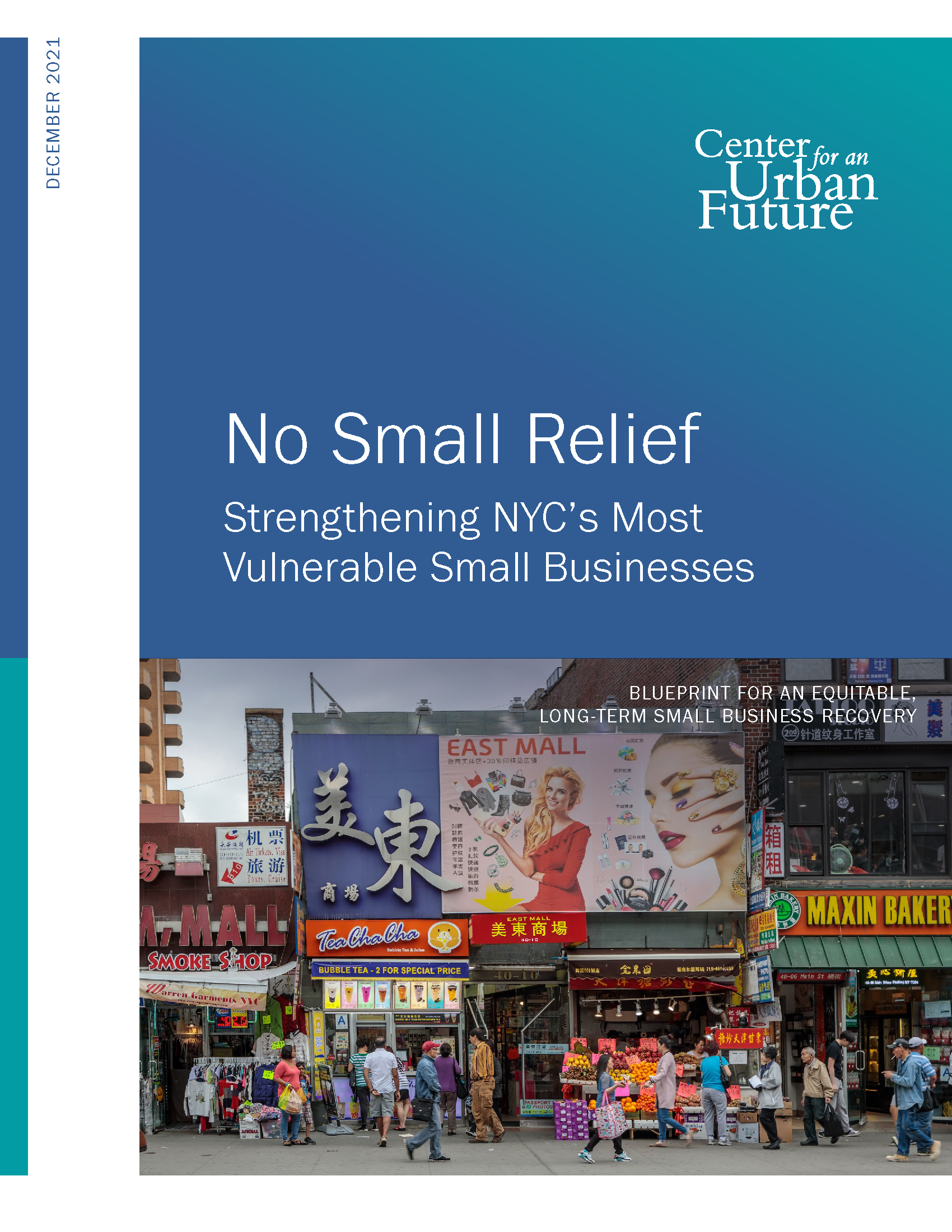The Untapped Potential of Community Development Financial Institutions (CDFIs)
Following nearly three years of a pandemic that has had a disastrous impact on small businesses in communities of color across New York City, there is broad consensus that new city and state government policies and investments are needed to strengthen the city’s minority- and immigrant-owned businesses. Of all the solutions policy leaders should consider, few would have a greater impact than expanding the reach of the city’s Community Development Financial Institutions (CDFIs).
Although New York is home to dozens of excellent small business development organizations, the relative handful of nonprofit CDFIs across the five boroughs stand out for their unique ability to connect the city’s smallest, most vulnerable businesses with access to capital and technical assistance. CDFIs have built up trust with immigrant- and minority-owned businesses and are often the only place where first-timeand smaller-scale entrepreneurs can get financing. Indeed, when thousands of minority- and immigrant-owned businesses in New York were unable to access the federal Paycheck Protection Program via traditional banks or take advantage of the city’s emergency grant program for small businesses, CDFIs filled the void, providing a financial lifeline to many at-risk firms.
The problem is that CDFIs serve only a tiny fraction of the businesses and aspiring entrepreneurs who could benefit from affordable loans and business advising services. Our research shows that most nonprofit CDFIs in the city make no more than a few hundred loans each year, with some CDFIs closing less than two dozen. This is a drop in the bucket—and a striking missed opportunity in a city that’s home to more than 64,500 minority- owned employer businesses and tens of thousands more microentrepreneurs, the majority of whom face enormous difficulty accessing capital.1
The Business Outreach Center Network (BOCNet), for example, made 187 new or refinanced loans in 2021. Brooklyn Cooperative Federal Credit Union, with branches in Bushwick and Bedford-Stuyvesant, makes about 100 new small business loans each year, lending only about $500,000 annually. Accompany Capital made 319 new small business loans in 2021, totaling $7.2 million. Greater Jamaica Development Corporation’s Southeast Queens Capital Access program makes just 10 to 30 small business loans in a typical year.
Overall, CDFIs account for just 0.4 percent of all small business debt lending in New York City annually.2 Although the reach of CDFIs is similarly limited in other parts of the country, data shows that New York’s CDFIs lend considerably less money than those in other major American cities. CDFIs made $138.3 million in loans to businesses in New York City’s five boroughs in 2017, compared to $210.3 million in Los Angeles County and $235.2 million in Cook County, Illinois, where Chicago is located.3
In addition to serving a relatively small number of entrepreneurs overall, CDFIs often lack the capacity to reach the most underserved businesses. These indispensable organizations currently have a limited footprint and extremely limited funding to cover the costs of staffing, marketing, and outreach. Several of the city’s lowest- income zip codes don’t have a single CDFI branch, and the businessowners and entrepreneurs who most need their services are often unaware they even exist.
To bolster New York’s minority- and immigrant-owned businesses and help create community and generational wealth in underserved and under-resourced neighborhoods, city and state leaders should provide new resources to CDFIs, enabling them to scale up their operations, boost the number of businesses they help with financing and advising, and extend their reach into communities with the greatest needs.
This policy brief puts forth several achievable recommendations for helping New York City’s CDFIs expand their reach and increase the number of minority- and immigrant businesses they can serve with small loans, technical assistance, and other support services. The brief, made possible thanks to a grant from HSBC, also documents why CDFIs are crucial to bolstering New York City’s most vulnerable businesses and provides a new level of detail about the capacity challenges facing CDFIs on the ground today.

Why CDFIs?
CDFIs play an indispensable role in low-income, minority, and immigrant communities. They fund and advise the small businesses that often go unserved by banks, city government agencies, and even other nonprofit small business assistance organizations. Part alternative lenders and part business counselors, CDFIs have the trust of these businesses and understand the unique obstacles and opportunities that they face.
Crucially, CDFIs fill a significant gap in the marketplace for entrepreneurs who are unable to acquire a bank loan and for whom other options, such as credit card debt or high-interest personal loans, are prohibitively expensive. In a financial marketplace of data-driven decision-making, CDFIs stand apart as “story lenders,” spending the time required to understand the complete picture of a business owner and providing hands on technical assistance in addition to capital. For a first-time entrepreneur wanting to open a flower shop on Fordham Road, an immigrant seamstress looking to set up a clothing alterations business in Sunset Park, or a food cart vendor in Corona looking to start a storefront restaurant, a CDFI may be the only financial institution able to offer affordable capital on flexible terms.
CDFIs were even more essential during the pandemic, when they helped thousands of small businesses access relief dollars and ride out months of closures and two-plus years of diminished revenues. In 2020, CDFIs in New York disbursed $295 million dollars in capital relief to struggling small businesses across the state and assisted with 32,612 COVID-19 disaster relief applications, while continuing to make loans to help small business owners cover expenses and even invest in growth.4
Most CDFIs serve just a fraction of the small businesses that would benefit from their services.
Small businesses in New York City face unmet capital needs of approximately $45 billion each year, with minority- and immigrant-owned businesses dealing with the most acute challenges accessing capital.5 CDFIs are uniquely well-positioned to help solve this financing gap, but often lack the capacity to do so.
New York City has approximately 36 CDFIs that focus on small business lending, but only 10 to 12 of them make at least 50 loans per year, according to industry experts. And even these “more active” microlenders generally provide fewer than 350 loans annually.
Nearly all of the CDFIs we interviewed agree that they are reaching a small fraction of the minority- and immigrant-owned businesses that could benefit from their financing and advising services, and they see significant potential for their services to expand. Across more than 20 interviews with CDFIs conducted for this report, industry leaders say that the potential market for their products and services is anywhere from double or triple to more than ten times larger than their current client base.
“It’s easily ten times, or more, the number of potential clients out there whom we’d like to be serving but can’t today,” says Yanki Tshering, founder and executive director of Queens-based Accompany Capital.
“At a minimum, we’d double or triple the amount of lending we’re doing with sufficient capital to lend and resources to support our capacity-building needs,” adds Aisha Benson, CEO of Nonprofit Finance Fund and former executive vice president and chief operating officer at TruFund Financial Services, a New York City-based CDFI with operations in six states." (Here and elsewhere in this report, Benson is speaking about her time at TruFund Financial Services.)
“The lack of scale is absolutely ridiculous,” says Connie Evans, president and CEO of the Association for Enterprise Opportunity, a national membership organization for microbusinesses. “There is such limited capacity to get money on the street.”
Geographic gaps limit the reach of CDFIs on the ground.
It’s not just that CDFIs serve a fraction of those entrepreneurs who are eager to secure affordable capital, but struggle to access it. Another related problem is that most CDFIs aren’t reaching low-income entrepreneurs in many communities with the greatest needs.
Because of limited capacity, CDFIs often locate in—and concentrate staff resources on—neighborhoods with the most entrepreneurs actively seeking out their capital. While such a strategy is understandable, the result is that these vital organizations lack physical locations and visibility in neighborhoods whose residents are less familiar with CDFIs but would benefit enormously from their services, including communities with a concentration of public housing developments and several of the city’s lowest-income zip codes. Many CDFI leaders interviewed for this report explain they would like to assist more low-income entrepreneurs who are currently underserved by existing business support infrastructure, but they say that their organizations lack the capacity to do dedicated outreach in NYCHA developments and other communities where needs are high.
New York City Lacks CDFI Locations in Eastern Brooklyn and the Central Bronx
Dots indicate physical CDFI locations. Red areas are neighborhoods with the lowest income levels.
Source: Data on CDFI locations from the U.S. Department of the Treasury CDFI Fund database. Data on neighborhood income levels from the 2016-2020 American Community Survey.
“We’ve got NYCHA residents in our backyard, but we’re not seeing them coming through the door. The actual conversions of aspiring entrepreneurs into clients were few and far between,” says Alethia Mendez of Grameen America, a nonprofit microlending organization based in New York City. “We needed to bring those resources to the NYCHA campus—it wasn’t enough to just say these resources exist.”
Fewer than five of the CDFIs we interviewed say they offer programming that regularly reaches NYCHA residents through partnerships and other forms of outreach. In addition, we mapped the physical locations of CDFI offices and found that, in several neighborhoods across the city, small business owners and microentrepreneurs do not have a local CDFI to turn to—limiting awareness of CDFIs in the first place. Indeed, all the CDFIs in the city have a total of just 85 offices or branches across the five boroughs, and the lion’s share of this total comes from the handful of banks that operate with a CDFI designation. Nonprofit CDFIs, which are far more likely than their banking counterparts to serve the most vulnerable businesses and those needing the smallest loans, have fewer than 25 locations citywide.
The gaps are particularly notable in several lower- income communities with a majority-minority population, including the area around Tremont, Mount Hope, and Jerome Avenue in the Bronx; East New York and Brownsville in Brooklyn; and Far Rockaway in Queens. Staten Island is home to just a single CDFI branch, in Tompkinsville.
Physical gaps in CDFI coverage across the city have a material effect on the ability of CDFIs to reach more potential clients, says Daniel Gonzalez, director of lending at Brooklyn Cooperative Federal Credit Union. “Branches are a key part of the strategy to raise our visibility and help more people,” says Gonzalez. “The biggest challenge is letting people know that we’re here. And the biggest marketing tool is still word of mouth.”
Endnotes
1. As the Federal Reserve noted in its 2022 Small Business Credit Survey, “Firms owned by people of color were more likely to apply for traditional financing than white-owned firms, but they were less likely to receive the funding sought.” Federal Reserve Banks, 2022 Report on Firms Owned by People of Color, June 2022, https://www.fedsmallbusiness.org/survey/2022/2022-report-on-firms-owned-by-people-of-color.
2. Next Street and Common Future, New York City Small Business Ecosystem Assessment, February 2021, https://nextstreet.com/research-and-publication/meeting-small-businesses-where-they-are-nyc.
3. Total dollar amount of Community Development Financial Institution (CDFI) investments that closed in 2017, as self-reported through the Community Investment Impact System and accessed through PolicyMap.
4. New York State of Opportunity and Empire State Development, Community Development Financial Institutions Assistance Program Annual Report, 2020, https://esd.ny.gov/sites/default/files/news-articles/2021-CDFI-Report.pdf.
5. Next Street and Common Future.







